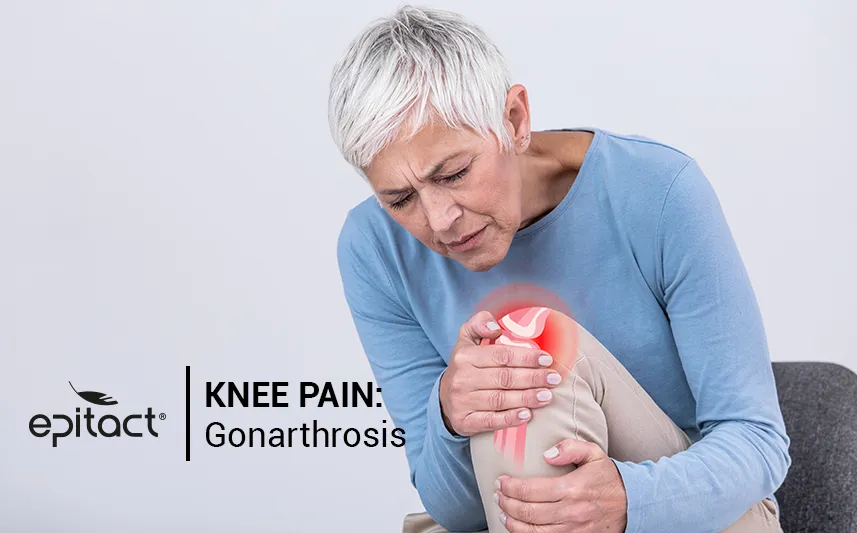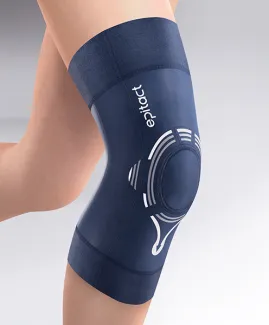
Do you have chronic knee pain? You may have osteoarthritis (OA) of the knee. This joint disease is very common, especially in the knees, and can be extremely disabling.
First, discover what is osteoarthritis of the knee (or knee OA). Second, learn about the 4 stages of knee osteoarthritis. Third, EPITACT® explains to you how it appears and how to relieve it.
What is knee OA, or knee osteoarthritis?
According to the World Health Organization, osteoarthritis is defined as “the result of mechanical and biological phenomenon that destabilise the balance between the synthesis and the destruction of the cartilage and the subchondral bone…”. In other words, osteoarthritis is the destruction of the cartilage inside a joint that results from a multifactorial phenomenon. This condition is disabling, chronic, painful and economically expensive.

Knee osteoarthritis, knee arthritis or gonarthrosis?
Osteoarthritis of the knee is employed as a synonym of knee arthritis or gonarthrosis, which is far less used. It is not always clear how to name knee osteoarthritis and the difference with arthritis. Actually, arthritis includes a wide range of degenerative joint diseases (more than 100!) whereas osteoarthritis is the most common form of arthritis (along with rheumatoid arthritis).
Arthritis is an inflammatory disease of a joint. Osteoarthritis is a non-inflammatory disease. While knee arthritis has infectious or metabolic causes, knee OA has mechanical origin. This means it is caused by the breakdown of cartilage which covers and protects bones in the knee.
By progressing, the cartilage may be totally destroyed and bones end rubbing together, leading to acute pain, impaired function of the knee and reduced mobility.
Different locations of osteoarthritis of the knee
The knee joint is made of the femur (thighbone), the tibia (shinbone) and the patella (kneecap) in the front of the knee. These three bones are connected together by passive (e.g.: ligaments, capsule, meniscus…) and active (e.g.: tendon) support structures.
So, inside the joint, the thighbone is articulated through its condyles with the tibial plateau. Between the condyles, there is a groove named trochlea where the (kneecap) hinges on. According to this configuration, there are three types of osteoarthritis of the knee:
- tibiofemoral osteoarthritis of the internal and/or external compartment, i.e. located between the internal condyle of the femur and the internal part of the tibial plateau, or between the external condyle and the external part of the tibial plateau. That represents 50% of cases of gonarthrosis;
- patellofemoral osteoarthritis affects the joint between the trochlea and the patella. It represents around 35% of cases;
- Osteoarthritis combining the two previous represents around 15% of cases.
What are the 4 stages of knee osteoarthritis?
In order to identify the stage of osteoarthritis of the knee, an X-ray exam is needed in addition to a physical examination. The clinical exam is conducted by a general practitioner to make the differential diagnosis, which is then validated by an X-ray. This imaging is made standing up, loaded and knee bent at a 30° angle (schuss).
According to the results, he is able to establish the stage of your knee osteoarthritis:
- stage 1 = narrowing of less than 50% of the joint space;
- stage 2 = narrowing of more than 50% of the joint space;
- stage 3 = a total loss of joint space;
- stage 4 = a total destruction of the cartilage between two bones that are directly in contact.
Causes and risk factors of osteoarthritis of the knee
According to an American study conducted in 2013, 8.5 million UK adults are estimated to have clinical osteoarthritis defined on the basis of symptoms and physical findings. Knee OA before the age of 45 affects only 3% of people.
However, the risk increases with age: around 80% of people aged 80 develop osteoarthritis. Women are twice as likely to have osteoarthritis. This condition also concerns more people with high Body Mass Index or with co-morbidities.
So, several studies, have emphasised major risk or aggravating factors of osteoarthritis of the knee:
- age;
- gender;
- weight;
- anatomical axial misalignment (genu valgum or varum, coxa vara or valga);
- postural axial misalignment (pronation or supination of the foot);
- important muscle imbalance;
- past traumas (fracture or ligament rupture);
- sport and/or professional overwork;
- inflammatory or metabolic disease.

How to relieve knee OA?
An American study carried out in 2007 revealed that by the year 2030, there will be an increase of 673% of surgery for a knee joint replacement. However, surgery must be considered as the last option and other treatments should be tried first to reduce pain:
- physiotherapy sessions;
- orthopaedic soles;
- knee braces;
- drug therapy;
- nutritional follow-up;
- corticoids or hyaluronic acid injections;
- surgery, either knee joint replacement or osteotomy to correct bone misalignment.

What is the EPITACT® solution for knee arthritis?
EPITACT® has created and patented a special support brace for knee arthritis: PHYSIOstrap™ Medical*. It is made of a soft, thin and flexible fabric that enables you to wear it on a daily basis and under any type of clothes.
It also includes a unique technology called EPITHELIUMFLEX™. This is a specific silicone tendon that surrounds the kneecap in order to stabilise it and guide it in the femoral trochlea during flexion movements.
This knee brace offers great comfort as it does not reduce your range of motion. Moreover, the fabric over the kneecap and behind the knee (popliteal fossa) is thinner, so it does not create pressure nor irritation on the skin.
To avoid it slipping on your leg, both extremities are covered with small silicone dots with a good anti-slip effect on the skin.
We hope you have understood what osteoarthritis of the knee is and what is the difference with knee arthritis. To know what of the 4 stages of knee osteoarthritis you’re at, consult your general practitioner.
EPITACT® suggests more articles about knee OA: its symptoms, causes and treatments in detail!

*This solution is a class I medical device that bears the CE marking under this regulation. Carefully read the instructions before use. Manufacturer: Millet Innovation. 09/2020
For more details about this general and simplified approach, here are further sources:
The epidemiology and impact of pain in osteoarthritis, T. Neogi, Clinical Epidemiology Research and Training Unit, Boston University School of Medicine, Boston, MA, USA, Osteoarthritis and Cartilage 21 (2013)
Guillemin F, Rat AC, Roux CH, Fautrel B, Mazières B, Chevalier X et al.; KHOALA cohort study. The KHOALA cohort of knee and hip osteoarthritis in France. Joint Bone Spine 2012; 79:597-603.
Kurtz S, Ong K, Lau E, Mowat F, Halpern M. Projections of primary and revision hip and knee arthroplasty in the United States from 2005 to 2030. J Bone JointSurg Am 2007;89:780-5
Professeur Dominique SARAGAGLIA, Les indications chirurgicales dans la gonarthrose, Corpus Médical – Faculté de Médecine de Grenoble, Mars 2003
Richette P. Généralités sur l’arthrose : épidémiologie et facteurs de risque. EMC - Appareil locomoteur. janv 2008; 3(4):1‑5.
 Pharmacie
Pharmacie